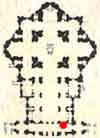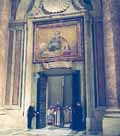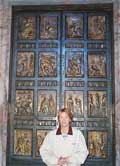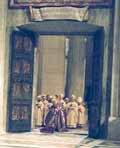| Grottoes
Vatican City Colonnade Saints Floorplan #2 |
| Altars
Monuments The History |
| Related
Items Holy Door Panels Door of Death Portico |

|
The Holy Door or 'Porta Sancta' is only open during a Holy Year (Jubilee), which occur every 25 years (the last one in 2000). On the first day of a holy year, the Pope strikes the brick wall with a silver hammer and opens it to the pilgrims. The message imparted by the Holy Door is that God's mercy reaches out to mankind's frailty. From inside the basilica, you'll notice that the door is walled up. |
From: 'St. Peter's - Guide
to Basilica and Square'
The last door on the right is the "Holy Door". This door is bricked up
on the inside. On the first day of the Holy Year the Pope strikes the
brick wall with a hammer, and so opens the door to let in the pilgrims
who come to make the most of the indulgence. It will be closed by the
Pope himself at the end of the Holy Year. The Holy Door represents Jesus,
the Good Shepherd and the gate of the sheep pen: "I am the gate. Whoever
enters through me, will be safe. He will go in and out, and find pasture"
(Jn 10:9). The Holy Year is celebrated every 25 years. In this century
two extraordinary Holy Years of Redemption have also been celebrated on
the anniversary of Jesus' death on the Cross: 1933 and 1983. When the
wall is knocked down, the bronze panels of the door made by Vico Consorti
appear. Since 24 December 1949 they have replaced the former wooden panels
made in 1749.
This door is also called the "Door of the Great Pardon". Its panels portray scenes of man's sin and his redemption through God's mercy:
1. Through disobedience Adam and Eve turned away from God and happiness and were chased from the garden; Mary receives the announcement of salvation from the angel and directs humanity back to God.
2. Through Baptism, Jesus permits us to join his People; he comes to seek us when we stray from him, as the shepherd goes in search of his lost sheep; he awaits our return and welcomes us at the door, as the father welcomes the prodigal son; he cures those who are paralyzed sin.
3. Jesus opens the door of new life to the woman who is sinful but can love; Jesus tells Peter says that one must forgive seventy times seven times. Jesus trusts anew in the man who promises fidelity and then denies him; Jesus opens the door of heaven to the thief who calls on him.
4. Jesus unlocks the heart of doubting Thomas to the faith; he gives his Spirit to the Apostles to enable them to forgive sins; he tumbles Paul from his horse and suddenly opens up a whole new world to him; he knocks at everyone's door and waits for us to open it.
From:
'St. Peter's Basilica - A Virtual Tour' by Our
Sunday Visitor
At the right end of the atrium is the Holy Door. In 1949 it was furnished
with two bronze wings with eight compartments on each side, produced by
Vico Consorti, known as the "maestro degli usci" (master of the doors)
because of his various works of commemorative doors.
The Door is purposefully based on a peaceful and expressive decorum and a symmetrical layout, since it was destined to remain closed, revealing the wall to be knocked down every Holy Year. Information about this solemn ceremony dates back to the Jubilee of 1500, under the papacy of Alexander VI, 200 years after the institution of this solemn pardon by Bonifacius VIII, who established that the ceremony would be repeated every 100 years. Afterwards, Clement VI reduced the period to every 50 years, Urban VI to 35 and Paul II to 25.
However, Jubilees were also celebrated outside these predetermined time periods. For example in 1933, with the Jubilee proclaimed by Pius XI to celebrate the anniversary of the death of the Redeemer and in 1983, with the one proclaimed by John Paul II, which is commemorated in one of the marble memorial stones located above the Door. The other stone refers to the last Jubilee celebrated by Paul VI.
From: Guide to
St Peter's Basilica, © 2003, Libreria
Editrice Vaticana
Last to the right of the atrium is the Holy Door (3.65m X 2.30m). It was
closed with a rough wall until 1949, as it was framed with marbles commissioned
by Gregory XII for the Jubilee of 1575, then renewed by Paul V. In 1949
the Bishop Francesco Von Streng donated the two bronze panels for the
Swiss Catholics, as an ex-voto, because his land was saved from war. It
is a work of art full of quiet expressivecomposure and symmetric structure,
divided into sixteen rectangular panels distributed in four orders, divided
by the coat-of-arms of the thirty six Popes, who celebrated the ordinary
Holy Years.
Books
The best English resource on the Holy Door is the book by Virgilio Cardinal
Noč, 'The Holy Door in St. Peter's', Ats Italia Editrice, 1999, ISBN 88-86542-69-0.




